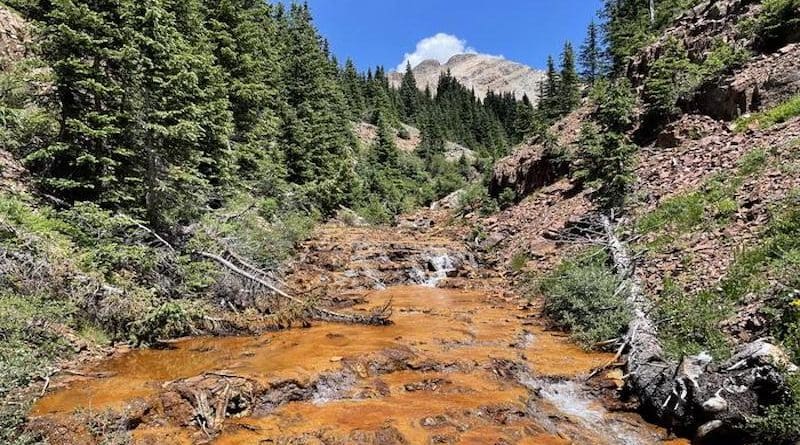Warming Climate Is Putting More Metals Into Colorado’s Mountain Streams
Warming temperatures are causing a steady rise in copper, zinc and sulfate in the waters of Colorado mountain streams affected by acid rock drainage. Concentrations of these metals have roughly doubled in these alpine streams over the past 30 years, a new study finds, presenting a concern for ecosystems, downstream water quality and mining remediation.
Natural chemical weathering of bedrock is the source of the rising acidity and metals, but the ultimate driver of the trend is climate change, the report found.
“Heavy metals are a real challenge for ecosystems,” said lead author Andrew Manning, a geologist with the U.S. Geological Survey in Denver. “Some are quite toxic. We are seeing regional, statistically significant trends in copper and zinc, two key metals that are commonly a problem in Colorado. It’s not ambiguous and it’s not small.”
The study was published in Water Resources Research AGU’s peer reviewed journal for original research on the movement and management of Earth’s water.
Although the mechanism coupling warming temperatures to increased sulfide weathering is still an open research question, the new results point to exposure of rock once sealed away by ice as a top suspect, Manning said. The sudden appearance of “rusting Arctic rivers” flowing out of regions of thawing permafrost in the last couple of years is likely the same process, magnified.
Colorado is riddled with patches of bedrock rich in metal sulfides. Shiny iron sulfide, familiar to many Coloradans as fool’s gold, or pyrite, is the most common of these sulfide minerals, but copper, zinc and other metal sulfides are also common.
Exposure to air oxidizes the metal sulfides in bedrock, releasing the metals into groundwater, which flows into surface streams. Rusty red deposits in streambeds are distinctive signs of iron sulfide oxidation. Sulfides also acidify the water, which can accelerate weathering. Some alpine streams sampled were found have a pH as low as 3 or 4.
The study drew on 40 years of water chemistry data, taking final samples from all sites in 2021, from 22 headwater streams in 17 watersheds that are naturally acidic and metal-rich enough to limit aquatic plants and animals. Sampling sites were above 3,000 meters (10,000 feet) elevation and included a mix of pristine, untouched areas and places that had been mined historically, but left alone for 50 to 100 years.
“The key point is no recent mining or remediation work has been done,” Manning said. “These watersheds have just been sitting there responding to nothing other than the climate.”
Warming, drying mountains
Mountain streams were sampled from mid-July to November, spanning the late summer and fall low-flow period. Long-term records of flow volume from nearby stream gauges show streamflows have been dwindling with warming temperatures and smaller snowpacks, suggesting smaller water volumes could explain the higher metal concentrations.
But Manning and his colleagues found less water could only account for half the effect they observed. To reach the concentrations they were seeing, the mountains had to be putting metals and sulfate into streams at a faster rate.
As these metal-rich mountain streams flow down into larger rivers, the effect of the extra metal load is diluted, the researchers noted.
“I don’t think this is a big red flag for major metropolitan or agriculture users way downstream at lower elevations,” Manning said, “but some of our mountain communities get their water only a short distance down from these mineralized streams.” To help mitigate the water quality risk, managers could benefit from advance knowledge of what metals are entering the stream, and where and how fast they are increasing, Manning said.
More metals and acidity in these mountain streams could also impact decisions about where to invest limited funds for remediation of those that have been altered by historical mining, and where to stock fish to benefit tourism.
Local case, global pattern
Colorado’s watersheds are a dramatic case because of the unusual abundance of bedrock metal sulfides, Manning said, but scientists are observing more subtle rising sulfate concentrations in mountain streams around the world. The new study is the first to statistically connect accelerated sulfide weathering to rising temperatures on a large scale across an entire region.
The study found the biggest gains in metal loads in the highest, coldest mountain streams. Manning said this pattern points to thawing underground ice. Colorado’s highest elevations have annual average temperatures close to zero degrees Celsius (32 degrees Fahrenheit), putting them right at the boundary conditions for permafrost. Some peaks have warmed past the freezing threshold since 1980.
“Ice is like armor. Melt it and you create windows for groundwater to get into rock that has not seen water and oxygen for millennia, and it will begin to oxidize quite quickly,” Manning said.
Other possible mechanisms are falling water tables exposing fresh rock to air and melting rock glaciers releasing pockets of concentrated metals stored in the ice. Wetlands accumulate metals and may release a burst when water returns after dry periods. The study did not find a correlation between rates of rising metal concentrations and the presence of wetlands, rock glaciers or factors linked to falling water tables, although these could be playing a role in other regions. But all these possible mechanisms are consequences of climate change.
“There’s just no other logical explanation than this is a changing climate signal,” Manning said. “Nothing else would reach all these watersheds universally.”

